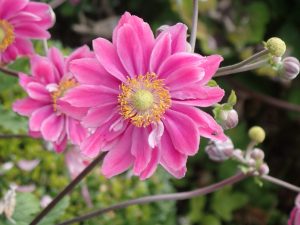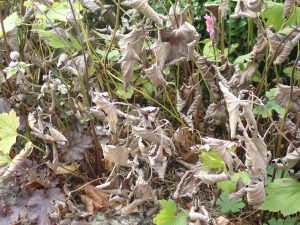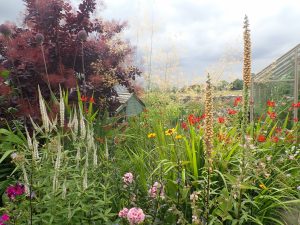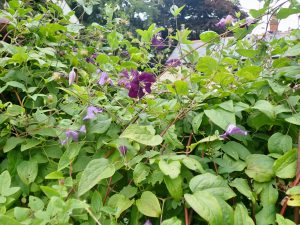Gardeners are used to battling the elements, but 2022 has been a catastrophic event. It began with an ‘I’m-not-going-to-grow-for-you-at-the-moment’ dry winter and cool spring. That was followed by extreme heat and strong Saharan winds, so most people’s gardens (including mine) turned into a sea of brown. One evening I sat and watched as hummingbird-hawk moths hovered over my buddleia flowers and just a few hours later those self-same mauve flowers had completely desiccated and turned brown overnight. Plants that normally thrive here, from crocosmias to sanguisorbas to tall yellow daisies, shrivelled up to nothing. Border phloxes, a big component at Spring Cottage, turned into brown sticks. My golden rod, and I grow a choice one called Solidago rugosa ‘Fireworks’, was an eyesore. It has failed for several years, along with Helianthus ‘Lemon Queen’.
There’s no escaping the fact: the effects of climate change are with us now. I have to say that I’ve found it fascinating and distressing in equal measures. On the one hand, I’m faced with a quandary. Do I get rid of my beloved border phloxes and replace them with more drought-tolerant plants, such as nepetas, calaminthas, sedums and deciduous eryngiums? Or shall I wait and see and possibly suffer the same fate again in my south-facing garden? I’m on the fence at the moment, because I love their genoa-cake scent, although not everyone is so enamoured. I’m certainly not prepared to pour water on them in order to keep them going, for water is a precious resource – as is time. The variegated phlox, ‘Norah Leigh’ was less affected, but all variegated plants seem to be able to survive on a mean diet.

I’m also wondering what to do about my stand of Japanese anemones running close to the cottage? I grow a single asymmetrical one named Anemone hupehensis ‘Bowles’s Pink’. Two of the five petals, the ones horizontally opposite each other, are a darker pink so it seems to wink at you in the border. It’s also a stronger grower for me than the similar looking ’Hadspen Abundance’. The other is a frilly, bright-pink somewhat shaggy semi-double named Anemone hupehensis var. japonica ‘Pamina’. Their foliage has shrivelled up and I’m reluctant to snip the cocoa-brown away, as it may be protecting the surviving stems. In extreme heat, the stone walls here radiate even more heat and exacerbate the temperature to 40C.

Some plants have shrugged off this summer’s heat and they include my many peonies. I’ve had bumper seeds and more growth on my Molly the Witch, Paeonia mlokosewitschii, now renamed P. daurica subsp. mlokosewitschii. In my experience, this pale-yellow single peony produces seedlings of mixed colours, so I shall be sowing all of my shiny black seeds despite them taking five years to flower. The offspring will probably be pink or peach. My repeat-flowering roses have also thrived, although their first flush of flower wilted in the first super-hot blast. I am reminded of seeing ‘Iceberg’, a miserable rose for most British gardeners, on a visit to South Africa. The stems on the standards were like tree trunks. On the debit side, there will be few rose hips, on my June-flowering roses.

The one thing this summer has taught me is the value of casting shade with taller planting. I grow a large purple-leaved cotinus, named ‘Royal Purple’, in one part of the autumn border and it has shaded all the plants on its northern side. I will be adding more flowering shrubs to my late-season borders, to create multistorey planting, in order to dissipate the effects of strong sunlight. One possible candidate is the black, cut-leaved elder, Sambucus nigra f. porphyrophylla ‘Eva’. This also sold as ‘Black Lace’. The domed pick flowers should sit easily in the border. Dark foliage enhances tall grasses and their linear foliage has been unaffected by the heat.

On the left-hand side of the autumn border, I planted a clematis screen using viticella varieties, such as ‘Étoile Violette’ and ‘Little Baz’, purely for privacy. This clematis hedge has screened the worst of the sun from this border, so it looks relatively. I’ve added more viticellas to climb through roses and ‘Alba Luxurians’, a wispy green-streaked white, will eventually scramble through a less-than productive apricot.
Clematis suppliers (such as Thorncroft and Taylors) have viticella sections on their web pages. This Mediterranean clematis species is well-equipped to survive hot weather and clematis varieties raised from this species produce myriad small flowers from July onwards. Pruning is simple too. Just cut them back low in mid-February. Clematis enthusiasts call this the February massacre.
Some areas of the garden have definitely benefitted from underground spring-fed water and, although this has diminished as this summer progressed, the soil has remained damper in these places. The border up the garden path is still relatively fresh, probably due to deep underground water. There’s also a metre-wide green circle in the lawn, which I’ve never noticed before, and I think the old cottage well must have been there. This circle of grass is so lush here, that I tripped over it!

If summers continue as they are, it will be vital to plant densely as well as casting shade. This preserves moisture at ground level and allows gardeners to succession plant. One of my problems this year is the failure of most of my annual plants. Blue cornflowers, blue clary, African marigolds, cosmos and nasturtiums, usually such good gap fillers, perished early on and exposed bare soil that baked in the sun. The two successes were green-leafed amaranthus, or love lies bleeding, and scabious. In fact, all scabious-like plants have done well. Scabiosa ochroleuca, a willowy perennial that produces small yellow-lemon pincushions, has thrived although its purple-spiked partner, Teucrium hircanicum, went over quickly. Normally they produce a striking combo in August and go on late into the year. The small blue buttons of Scabiosa columbaria, held on extremely long stems, edge paths and borders despite the weather. They are still satisfying bees and hoverflies, so the nectar must be flowing.
I hope the garden revives once September arrives, for this is usually one of the best months in the garden. The light is crystal clear and colours take on a vibrant lustre. There are refreshing dews, following cooler nights. What we really want is gentle rain to fall for several hours, because the heavy deluges we tend to get now just run off the dry surface. Anyone for a rain dance?



